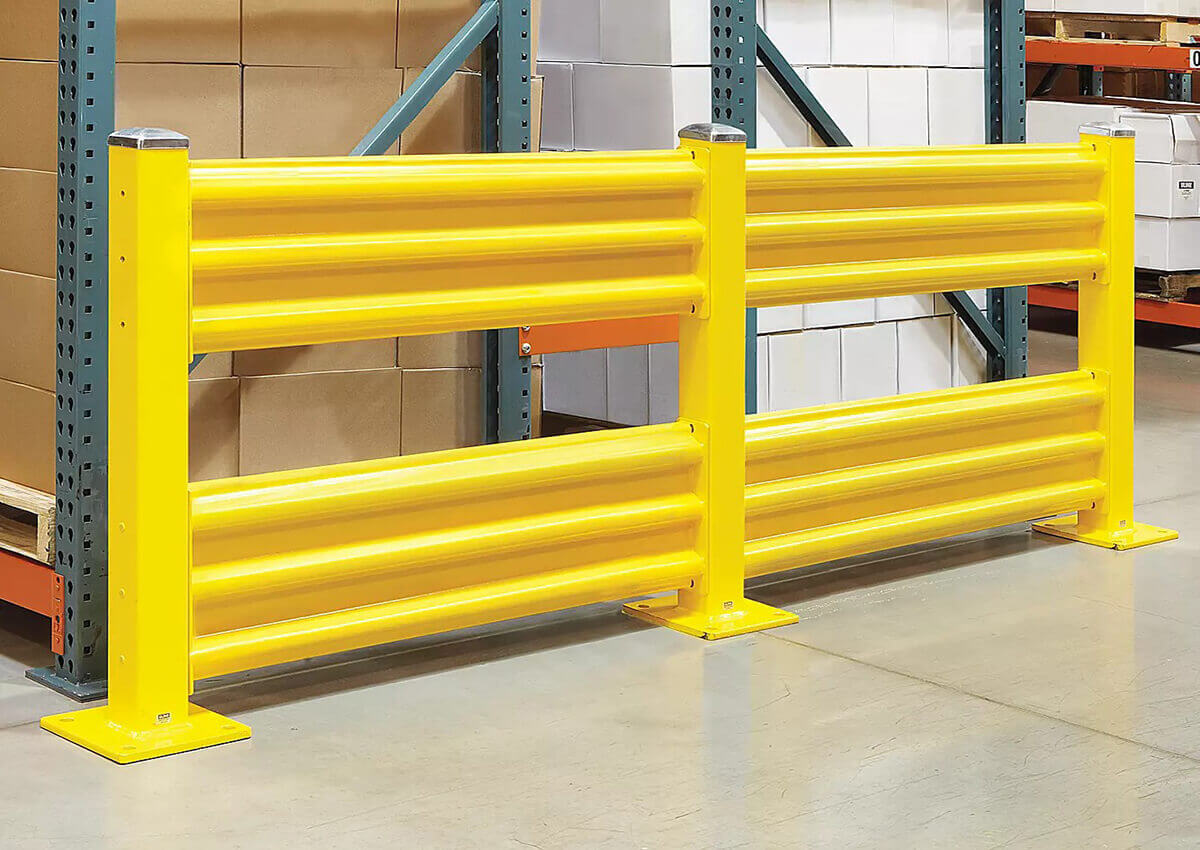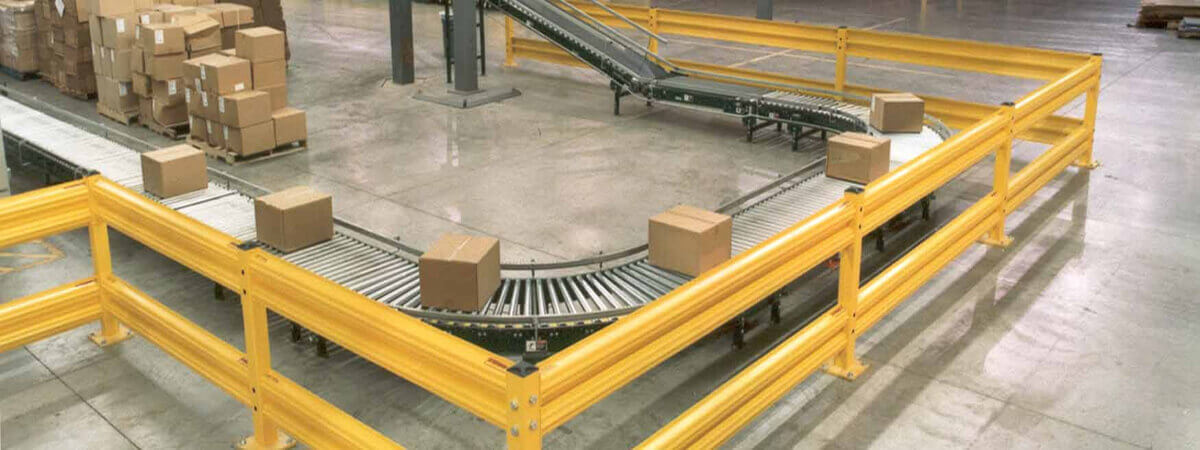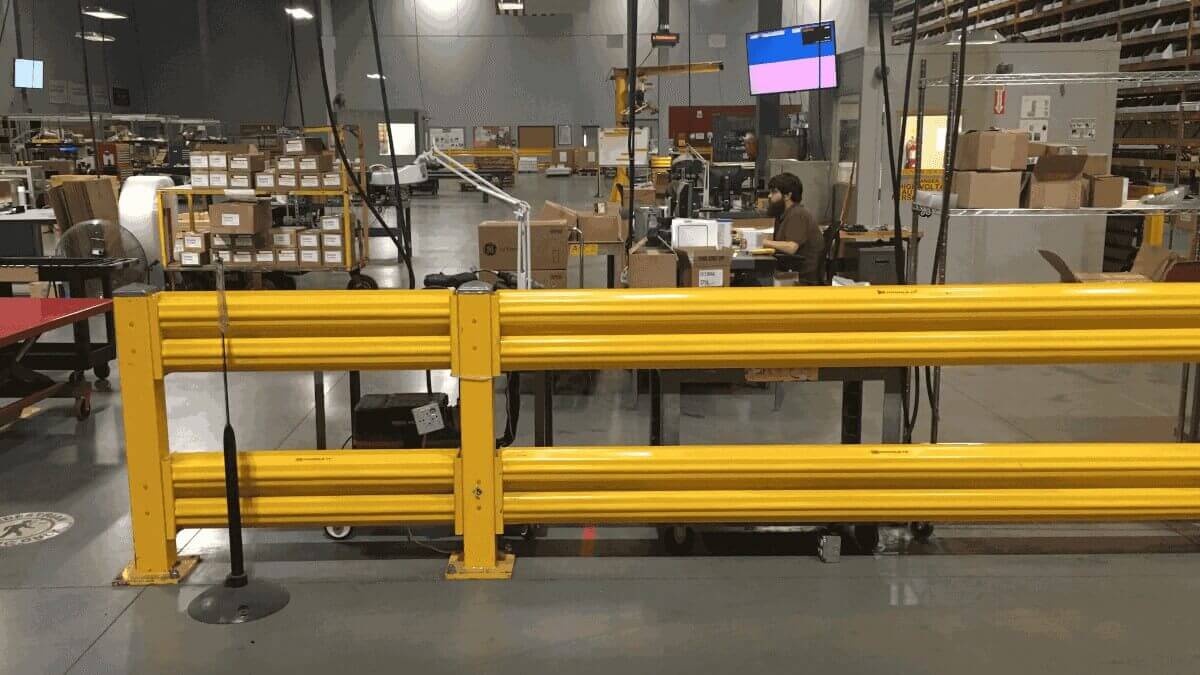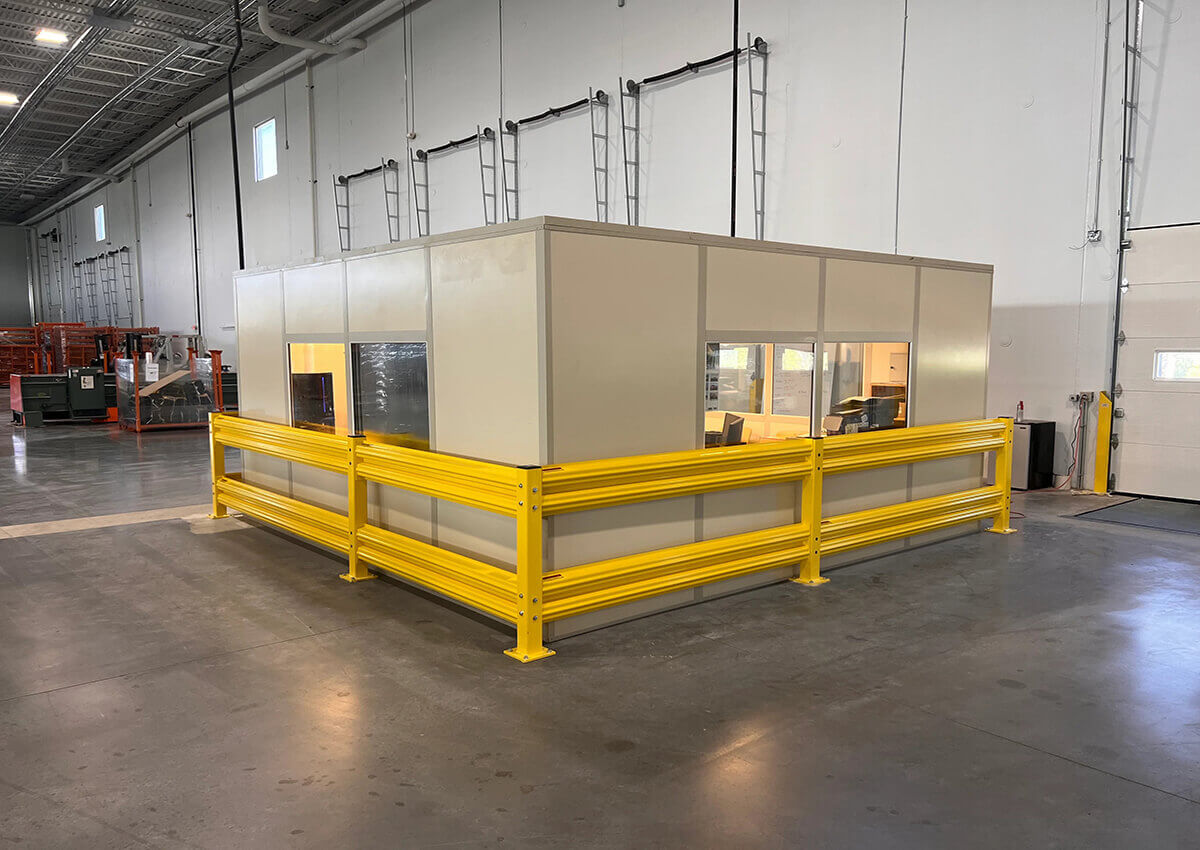Warehouses are the busy heartbeat of the logistics and supply chain world. They are home to countless goods and materials and centers of ongoing activity. In this busy environment, safety and efficiency are paramount. This is where warehouse guard rails come into play as silent sentries, providing protection for employees, equipment, and inventory.
Before starting our journey, let us understand what warehouse guard rails are and why they are crucial in the field of material handling and storage. Read on to learn more.
1. What is a warehouse guard rail?
Warehouse guard rails are sturdy protective barriers strategically placed within a warehouse or distribution center. The main purpose of guard rails in a warehouse environment is to keep items out (depending on your perspective). You need to place guards around your expensive machines and workers to ensure that forklift and pallet truck operators don’t accidentally hit them. When it comes to guard rails, the brighter the better to ensure they are fully visible against the backdrop of the warehouse.
Guard rails not only prevent the forklift from hitting your people and items, but they also limit the damage between any collisions. If you’re in a forklift, you’d rather hit a guard rail than run straight into a wall. The added buffer zone means it is easier and cheaper to repair or replace guard rails than walls, and it also limits damage to the forklift. Guard rails can also warn forklift operators that there are stairs to prevent them from falling.

2. Advantages of warehouse guard rails
Warehouse guard rails offer a variety of advantages in terms of safety and operational efficiency. Here are some of the main advantages of using guard rails in warehouses:
- Prevent Collisions: Guard rails act as physical barriers to protect equipment, machinery, and inventory from collisions with forklifts, pallet jacks, and other moving vehicles. They prevent costly damage to infrastructure and minimize the risk of accidents.
- Enhance personnel safety: Guard rails create designated walkways and separate them from vehicular traffic areas. This helps prevent accidents and injuries by keeping workers out of harm’s way and reducing the risk of unauthorized entry into hazardous areas.
- Improve traffic flow and organization: Guard rails can be strategically placed to direct traffic and define specific areas for different operations, such as loading docks or storage areas. The warehouse is streamlined, congestion is reduced, and goods and vehicles can be moved more efficiently.
- Visual Guidance and Hazard Identification: Brightly colored guard rails provide workers and drivers with clear visual guidance, helping them safely navigate the warehouse. In addition, guard rails can be equipped with reflective materials or warning signs to highlight potentially dangerous or restricted areas and further enhance safety awareness.
- Comply with regulations: Many industrial safety standards and regulations require the use of guard rails in warehouses and other industrial facilities. Businesses can reduce their risk of penalties and legal issues by implementing guard rails, which ensure compliance with safety guidelines.
- Cost-effective solution: While guard rails require an initial investment, they can provide long-term cost savings by preventing accidents and damage to infrastructure and inventory. By using guard rails correctly, the costs associated with workplace injuries, equipment repairs, and unplanned downtime can be significantly reduced or avoided.
- Versatility and Customization: Guard rails come in a variety of sizes, shapes, and materials and can be customized to the specific needs of your warehouse. They can be designed to suit different layouts, adapt to specific traffic patterns, and be easily integrated with other safety measures such as bollards, safety nets, or safety barriers.
3. Types of warehouse guard rails
There are many types of warehouse guard rails, each meeting different safety and operational needs.
1) Standard guard rail
- Sturdy Sentinels: Standard guard rails are made of durable materials such as steel or aluminum and have horizontal rails supported by sturdy posts.
- Versatility: They can be installed on walkways, around machinery, and on the edges of elevated platforms, providing protection with versatility.
2) Rack side protector
- RackingProtection: Rack end protectors are specifically designed to protect pallet racks from forklifts, pallet jacks, and other warehouse equipment.
- Cost-Effective Defense: They are a cost-effective way to prevent rack damage, protecting your inventory and budget.
3) Bollards
- Focused Protection: Bollards are individual posts or barriers strategically placed to protect specific areas or equipment within a warehouse.
- Traffic Control: They often serve the dual purpose of controlling the flow of vehicular and pedestrian traffic.
4) Modular guard rail system
- Customized Security: Modular guard rail systems offer flexibility and can be customized to fit a warehouse’s unique layout.
- Easy to install: These systems are relatively easy to install and can be reconfigured as operational needs change.

4. Warehouse guard rail application
Warehouse guard rails can be applied to various areas within a warehouse facility. The following are some of the most common applications for warehouse guard rails:
- Aisles and walkways: Guard rails are used to create safe walkways and provide a clear path for workers to move through the warehouse. They help separate pedestrian traffic from vehicle traffic, reducing the risk of accidents and promoting a safer working environment.
- Loading Dock: Install guard rails around loading dock areas to provide a physical barrier between workers and the edge of the dock. This prevents accidental falls or collisions with moving vehicles during loading and unloading.
Racking Systems: In order to prevent forklifts or other equipment from damaging or collapsing racks, guard rails can be installed along the ends of them. Their primary function is to act as a protective barrier, minimizing the risk of accidents and ensuring the stability of the storage infrastructure. - Equipment and Machinery Protection: To protect valuable equipment, machinery, and sensitive areas such as control panels or electrical cabinets from accidental impact or unauthorized access, guard rails are often installed. They help protect critical assets and prevent damage that could lead to downtime or expensive repairs.
- Hazardous Areas: Guard rails are used to isolate hazardous areas within a warehouse, such as areas containing heavy machinery, high-voltage equipment, or chemical storage. They act as visible physical barriers to prevent unauthorized entry and ensure that only authorized personnel have access to potentially hazardous areas.
- Traffic Management: Guard rails can be strategically placed to direct traffic flow and manage vehicle movement within the warehouse. They help define lanes, restrict certain areas, and create separation between opposing traffic, optimizing efficiency and reducing the risk of collisions.
- Mezzanines and Elevated Platforms: Guard rails are critical on elevated platforms and mezzanines to prevent falls and provide a safe working environment for employees working at heights. They act as protective barriers at the edges of elevated structures, ensuring worker safety.

5. Installation and maintenance of warehouse guard rails
To maximize the effectiveness of warehouse guard rails, proper installation, and regular maintenance are crucial. The following are tips for installing and maintaining warehouse guard rails.
1) Professional installation
- Certified Installation: Guard rails should be installed by trained professionals who understand safety regulations and guidelines.
- Customization: Installation experts can tailor guard rail layouts to your warehouse’s unique needs, optimizing their effectiveness.
2) Routine inspection
- Regular Inspections: Regular inspections make sure guard rails are in good condition and have no damage.
- Quick Repairs: If any damage or wear is discovered during inspection, it will need to be repaired immediately.
3) Training and awareness
- Employee Training: Personnel should be educated on the purpose of guard rails and how to work safely around them.
- Visual Indicators: The use of markers or signs can further enhance awareness of the location of guard rails within the warehouse.
6. Other names for warehouse guard rails
- Safety barriers
- Warehouse safety rails
- Industrial guard rails
- Protective railing systems
- Facility protection rails
- Traffic barriers
- Warehouse barrier systems
- Crash barriers
- Warehouse safety barriers
- Steel guard rails
- Protective guardrails
- Warehouse railing systems
- Safety handrails
- Barrier rails
- Warehouse edge protection

7. Frequently asked questions about warehouse guard rails
Here are answers to frequently asked questions about warehouse guard rails.
1) Why do I need guard rails in my warehouse?
Guard rails are essential in warehouses to enhance safety by providing physical barriers that prevent collisions, separate pedestrian and vehicular traffic, direct traffic flow, and comply with safety regulations.
For example, I have a friend. He is a box making machine manufacturer, and he has many box machines made for customers in his factory. To protect the product from forklifts and other machinery, he installed warehouse guardrails in the area where the product was placed. This not only protects the product but also protects pedestrian safety.
2) What are warehouse guard rails usually made of?
Common materials for warehouse guard rails include: Made of durable materials such as steel or high-strength plastic. The specific materials used can vary depending on the strength, durability, and environmental factors required for the warehouse.
3) How high should the warehouse guard rail be?
Warehouse guard rail heights may vary depending on specific applications and regulations. However, they are typically around 42 inches (106 cm) tall and are effective in protecting against accidental drops or bumps.
4) Is the guard rail easy to install?
Guard rail installation may vary based on specific products and requirements. Some guard rails are designed to be easy to install and can be assembled using simple tools, while other guard rails may require professional installation. Installing the product properly requires following the instructions provided by the manufacturer.
5) Does the guard rail require maintenance?
Guard rails generally have low maintenance requirements. Regular visual inspections are important to ensure your guard rails are in good condition and not damaged. Any damaged or damaged parts should be repaired or replaced immediately to maintain their effectiveness.
6)Are guard rails only used in warehouses?
While guard rails are commonly found in warehouses, they can also be found in a variety of industrial and commercial settings, such as manufacturing facilities, distribution centers, logistics yards, and parking lots, where they serve a similar purpose of protecting people, assets, and infrastructure.
7) Can guard rails be used for other purposes besides safety?
Yes, in addition to guard rails for safety, rails can also play other roles. For example, they can be used to direct traffic flow, define work areas, or even act as barriers for security or access control purposes within a warehouse or facility.
8) Can guard rails be customized to fit my warehouse layout?
Yes, guard rail rails can often be customized to fit the unique layout and requirements of a warehouse. Warehouse guard rail manufacturers can offer different sizes, configurations and installation options to meet specific needs.

8. Conclusion
Warehouse guard rails may seem inconspicuous, but their impact on safety, efficiency, and cost savings within a warehouse environment is huge. By understanding the different types, applications, safety benefits, and the importance of professional installation and regular maintenance, warehouse operators can create a safe and efficient workspace.
Guard rails act as silent sentries, protecting assets, employees, and operations, ensuring warehouses continue to run smoothly, incident-free, and with minimal financial risk. The above is our discussion about warehouse guard rails.





Leave A Comment